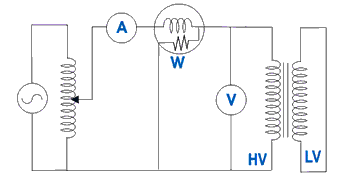The short circuit test is performed on a transformer to find series branch parameters and rated copper loss. This test is always preferred to perform on the high voltage (HV) side of the transformer. The short circuit test is always done at the rated current on that side of the transformer where the test is performed.
By doing this test, we are going to find
(i) Series branch parameters like
- equivalent impedance (Zeq)
- equivalent resistance (Req)
- equivalent reactance (Xeq)
(ii) rated copper loss (Wsc)
The connection diagram of short circuit test on transformer is shown in figure 1. This test is performed at the high voltage (HV) side. The low voltage (LV) side is short-circuited.

Note: For the production of rated current on either side, we don’t have to apply the rated voltage that is mentioned on the transformer nameplate. The rated current can be easily achievable at a very reduced voltage compare to the rated voltage.
The short circuit test is done at rated current but this rated current can be produced at very low voltage compared to the rated voltage.
While performing short circuit test on transformer, the voltmeter reads applied voltage (Vsc), the ammeter reads rated current (Isc), and the wattmeter reads rated copper loss (Wsc).
Why short circuit test is done on HV side of transformer?
The rated current in the windings can be achieved at a low voltage if testing is done on the high voltage (HV) side of the transformer. Another reason is that the rated current on the HV side is lower than the LV side. Hence the instruments (ammeter, and voltmeter) with lower range are readily available.
If short circuit test is performed on the LV side of the transformer, then the instruments (ammeter, and voltmeter) capable of handling high voltages and currents are not readily available. In order to achieve rated current, a source of rated voltage is needed. A source of such rated voltage (high value) is not readily available.
A primary voltage of 2 to 12% of the rated voltage is sufficient to circulate rated currents in HV and LV windings. As we know that at rated voltage, the exciting current is 2 to 6% of full load current.
As in the case of short circuit test, a primary voltage of 2 to 12% of the rated voltage is applied. Hence, the exciting current may be 0.04% to 0.72% of its full load current. This is a very low value. Therefore, we can ignore the exciting current and shunt branch. Figure 2 shows the approximate equivalent circuit when short circuit test on transformer is performed.

The equivalent impedance can be calculated as
$Z_{eq}=\frac{V_{sc}}{I_{sc}}$
The wattmeter reading (Wsc) gives rated copper loss. As we know that, the rated copper loss can be calculated as
$Rated\; copper\; loss=W_{sc}=I_{sc}^{2}R_{eq}$
The equivalent resistance can be calculated as
$\Rightarrow R_{eq}=\frac{W_{sc}}{I_{sc}^{2}}$
The equivalent reactance can be calculated as
$X_{eq}=\sqrt{Z_{eq}^{2}-R_{eq}^{2}}$
